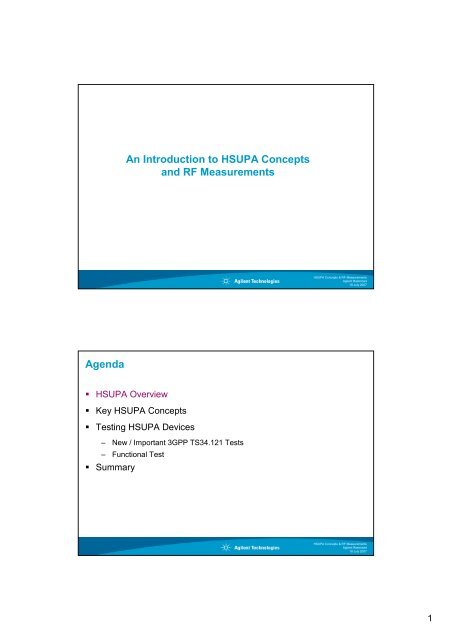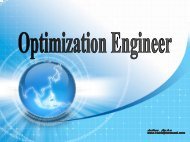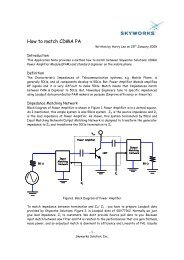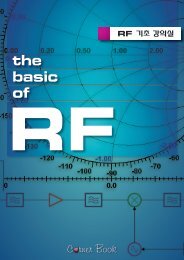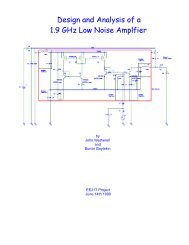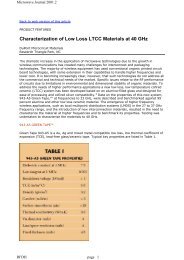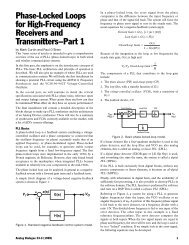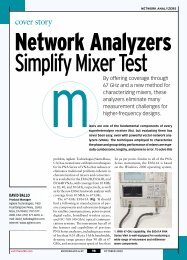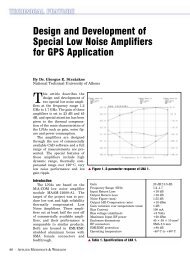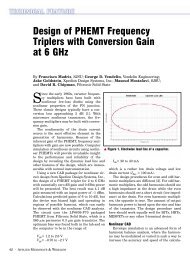(Microsoft PowerPoint - 1_HSUPA Concepts RF Measurements ...
(Microsoft PowerPoint - 1_HSUPA Concepts RF Measurements ...
(Microsoft PowerPoint - 1_HSUPA Concepts RF Measurements ...
Create successful ePaper yourself
Turn your PDF publications into a flip-book with our unique Google optimized e-Paper software.
<strong>HSUPA</strong> Market Influence<br />
“HSPA is as fast as 1xEV-DO”<br />
• 15 Mbps forward / 6 Mbps reverse<br />
• 14 Mbps downlink / 5.74 Mbps uplink<br />
1xEV-DO Release B<br />
HSPA<br />
<strong>HSUPA</strong> <strong>Concepts</strong> & <strong>RF</strong> <strong>Measurements</strong><br />
Agilent Restricted<br />
18 July 2007<br />
What is <strong>HSUPA</strong>? Why important?<br />
Three terms for the same thing:<br />
• <strong>HSUPA</strong> = High Speed Uplink Packet Access (market standard)<br />
• E-DCH = Enhanced Dedicated Channel (3GPP standards documents)<br />
• EUL = Enhanced Uplink<br />
HSPA = HSDPA + <strong>HSUPA</strong><br />
• Although can be used separately, will be used together for many applications<br />
such as VOIP or mobile gaming<br />
Purpose of <strong>HSUPA</strong> is to:<br />
• Increase UL throughput (data rates)<br />
• Increase network capacity<br />
• Reduce delays to improve performance of applications (like mobile gaming, 2-<br />
way VOIP)<br />
<strong>HSUPA</strong> <strong>Concepts</strong> & <strong>RF</strong> <strong>Measurements</strong><br />
Agilent Restricted<br />
18 July 2007<br />
2
<strong>HSUPA</strong> Overview<br />
Key features and changes<br />
• Allows uplink packet data to 5.74Mbps<br />
– 384 kbps is current practical limit with Rel 99<br />
• Hybrid ARQ similar to HSDPA, except UE sends, node B ACKs/NACKs<br />
• Node B provides fast scheduling, dynamically allocating power among UEs<br />
• New optional 2ms TTI (transmission time interval)<br />
– 10 ms TTI allows only 2 Mbps UL<br />
• 5 new physical channels<br />
– 2 UL, 3 DL<br />
• 1 new UL transport channel<br />
• Not a shared data channel<br />
as in HSDPA<br />
Architecture<br />
MAC<br />
Downlink<br />
IP / TCP / etc.<br />
PDCP<br />
RLC<br />
MAC-d<br />
MAC-es<br />
MAC-e<br />
Uplink<br />
L1<br />
E-DCH<br />
E-AGCH E-RGCH E-HICH E-DPDCH E-DPDCH E-DPCCH<br />
Absolute & Relative<br />
grants<br />
Ack/Nack Data Control<br />
<strong>HSUPA</strong> <strong>Concepts</strong> & <strong>RF</strong> <strong>Measurements</strong><br />
Agilent Restricted<br />
18 July 2007<br />
Agenda<br />
<strong>HSUPA</strong> Overview<br />
Key <strong>HSUPA</strong> <strong>Concepts</strong><br />
Testing <strong>HSUPA</strong> Devices<br />
– New / Important 3GPP TS34.121 Tests<br />
– Functional Test<br />
Summary<br />
<strong>HSUPA</strong> <strong>Concepts</strong> & <strong>RF</strong> <strong>Measurements</strong><br />
Agilent Restricted<br />
18 July 2007<br />
3
Uplink Channels<br />
Transport channel: E-DCH<br />
(Enhanced Dedicated Channel)<br />
• Carries 1 block of data each TTI: UE to Node<br />
B<br />
Physical channels:<br />
(Enhanced Dedicated Physical Data Channel)<br />
(Enhanced Dedicated Physical Control Channel)<br />
• Channels are IQ multiplexed<br />
– E-DPCCH on I<br />
– E-DPDCH mapping varies<br />
• E-DPCCH (carries control info to allow<br />
decode E-DPDCH<br />
– E-TFCI, RSN (Retransmission Sequence<br />
Number) and Happy Bit<br />
• E-DPDCH (carries user data)<br />
– Variable SF and quantity - 1*SF256 up to 2*SF2<br />
+ 2*SF4<br />
transport<br />
physical<br />
<strong>HSUPA</strong> <strong>Concepts</strong> & <strong>RF</strong> <strong>Measurements</strong><br />
Agilent Restricted<br />
18 July 2007<br />
Downlink Physical Channels<br />
E-HICH (Enhanced HARQ Indicator Channel)<br />
• Transmits ACKs/NACKs: Node B to UE<br />
– similar to HSDPA UL HS-DPCCH, except no<br />
CQI<br />
• Response occurs a fixed time after E-DPDCH<br />
transmission<br />
• Shares same code as E-RGCH<br />
E-AGCH (Enhanced Absolute Grant Channel)<br />
Provides absolute limit of max resources UE can<br />
use max E-DPDCH/DPCCH ratio<br />
• Shared channel CRC masked by UE ID<br />
E-RGCH (Enhanced Relative Grant Channel)<br />
Moves Serving Grant up/down/hold<br />
• Shares same code as E-HICH<br />
<strong>HSUPA</strong> <strong>Concepts</strong> & <strong>RF</strong> <strong>Measurements</strong><br />
Agilent Restricted<br />
18 July 2007<br />
4
HARQ<br />
Hybrid Automatic Repeat reQuest<br />
<strong>HSUPA</strong> has HARQ processes just like HSDPA, but in opposite<br />
direction - UE sends, Node B ACKs/NACKs<br />
4 HARQ processes for 10 ms TTI, 8 for 2 ms TTI<br />
Stop/wait operation - fixed round trip time (40 ms or 16 ms)<br />
Receiver: Node B<br />
Transmitter: UE<br />
<strong>HSUPA</strong> <strong>Concepts</strong> & <strong>RF</strong> <strong>Measurements</strong><br />
Agilent Restricted<br />
18 July 2007<br />
MAC-e/es (network)<br />
MAC-es (RNC)<br />
• Reordering queue<br />
• Macro diversity selection<br />
MAC-es<br />
to MAC-d<br />
Reordering<br />
Combining<br />
MAC-d flow<br />
to MAC-d<br />
Reordering<br />
Queue<br />
MAC-d flow<br />
MAC-e (Node-B)<br />
• Scheduler<br />
• De-multiplexer<br />
• HARQ processes<br />
MAC-e<br />
Scheduling<br />
/control<br />
HARQ<br />
process<br />
De-multiplexer<br />
HARQ<br />
process<br />
HARQ<br />
process<br />
E-R/AGCH<br />
E-HICH<br />
E-DCH<br />
<strong>HSUPA</strong> <strong>Concepts</strong> & <strong>RF</strong> <strong>Measurements</strong><br />
Agilent Restricted<br />
18 July 2007<br />
5
MAC-es/e (UE)<br />
Single sub-layer<br />
E-TFC (transport format combination) selection<br />
from MAC-d<br />
from MAC-d<br />
Multiplexing<br />
HARQ Processes<br />
MAC-e/es<br />
E-TFC<br />
selection<br />
Multiplexer<br />
HARQ<br />
process<br />
HARQ<br />
process<br />
HARQ<br />
process<br />
E-R/AGCH<br />
E-HICH<br />
E-DCH<br />
<strong>HSUPA</strong> <strong>Concepts</strong> & <strong>RF</strong> <strong>Measurements</strong><br />
Agilent Restricted<br />
18 July 2007<br />
Power Control<br />
Used by UE to calculate Serving Grant<br />
<strong>HSUPA</strong> does not change the fundamental way in which UE power<br />
control is managed in WCDMA<br />
• Node B still tries to balance the received power of the DPCCH from each UE in<br />
the cell to be roughly the same<br />
<strong>HSUPA</strong> allows for some UEs to<br />
transmit at higher data rates than<br />
others (and thus higher power levels)<br />
• <strong>HSUPA</strong> changes relative differences<br />
between power on transmitting E-<br />
DPDCHs and power of the DPCCH<br />
• Allows total power transmitted to remain<br />
same, while power on E-DPDCHs is<br />
increased to provide higher <strong>HSUPA</strong> data<br />
rates<br />
<strong>HSUPA</strong> <strong>Concepts</strong> & <strong>RF</strong> <strong>Measurements</strong><br />
Agilent Restricted<br />
18 July 2007<br />
6
Serving Grant<br />
UE Scheduling:<br />
Node B regulates how much data the UE can send<br />
UE maintains Serving Grant calculation - granted first by Absolute Grant,<br />
changed by Relative Grants<br />
• Updated each TTI<br />
Serving Grant controls the max power the UE can use to transmit data on E-<br />
DPDCH(s)<br />
• Determines max data rate – E-TFC tables give power needed for rates<br />
UE chooses E-TFC each TTI (based on available data to send and available<br />
power it is capable of transmitting). It can choose less than the Serving Grant<br />
allows.<br />
UE Reporting:<br />
UE provides feedback to node B each TTI Happy Bit<br />
Node B resources<br />
• Unhappy: UE cannot empty buffer in “n” ms, using all of Serving Grant, could TX at<br />
higher power otherwise Happy<br />
<strong>HSUPA</strong> <strong>Concepts</strong> & <strong>RF</strong> <strong>Measurements</strong><br />
Agilent Restricted<br />
18 July 2007<br />
<strong>HSUPA</strong> <strong>Concepts</strong> & <strong>RF</strong> <strong>Measurements</strong><br />
Agilent Restricted<br />
18 July 2007<br />
7
<strong>HSUPA</strong> UE Categories<br />
UE categories define the<br />
basic capabilities of the<br />
device<br />
TS25.306 Table 5.1a<br />
TS25.306 Table 5.1g<br />
Yellow highlight<br />
indicates categories<br />
introduced first<br />
<strong>HSUPA</strong> <strong>Concepts</strong> & <strong>RF</strong> <strong>Measurements</strong><br />
Agilent Restricted<br />
18 July 2007<br />
<strong>HSUPA</strong> RB Test Mode<br />
HSPA loopback – Need to loop back HSDPA DL data onto the<br />
<strong>HSUPA</strong> UL for <strong>RF</strong> testing<br />
HSDPA data rates must be chosen carefully<br />
• Need enough HSDPA DL data so that <strong>HSUPA</strong> UL will transmit when required<br />
(no unexpected DTXs)<br />
• But, not so much data that the UE buffer overflows excessively<br />
HSDPA and <strong>HSUPA</strong> are not symmetrical services<br />
• DL and UL data rates do not match<br />
(HSDPA data rates, block sizes and PDUs<br />
are not equal to those used on the UL for<br />
<strong>HSUPA</strong>)<br />
• Usual situation is to send enough data on<br />
DL to keep the UL continually transmitting<br />
in order to make <strong>RF</strong> measurements<br />
• UE will discard some of the DL data as<br />
defined in 3GPP TS 34.109<br />
<strong>HSUPA</strong> <strong>Concepts</strong> & <strong>RF</strong> <strong>Measurements</strong><br />
Agilent Restricted<br />
18 July 2007<br />
8
Agenda<br />
<strong>HSUPA</strong> Overview<br />
Key <strong>HSUPA</strong> <strong>Concepts</strong><br />
Testing <strong>HSUPA</strong> Devices<br />
– New / Important 3GPP TS34.121 Tests<br />
– Functional Test<br />
Summary<br />
<strong>HSUPA</strong> <strong>Concepts</strong> & <strong>RF</strong> <strong>Measurements</strong><br />
Agilent Restricted<br />
18 July 2007<br />
Why Test <strong>HSUPA</strong>?<br />
New uplink channels E-DPCCH and E-DPDCH<br />
Power Variations<br />
• Larger crest factor than HSDPA<br />
• Code channel relative power differences very large (up to 45 dB)<br />
• Large power changes at TTI boundaries – i.e., <strong>HSUPA</strong> on/off (up to 27 dB)<br />
Uplink configuration very dynamic. Each TTI, the following can change:<br />
• Number of E-DPDCH(s) transmitted<br />
• Spread factor of E-DPDCH(s)<br />
• Power of E-DPDCH(s)<br />
These changes adversely affect modulator performance and transmitter<br />
distortion more out-of-channel interference and poorer modulation quality<br />
• Examine modulation accuracy at code level vs. composite signal to ensure code channels are<br />
modulated correctly [5.2D and 5.13.2B]<br />
• Check for out-of-channel interference due to increased spectral splatter [5.9B and 5.10B]<br />
• Ensure max power is reached but not exceeded to ensure adequate coverage without interfering<br />
with other channels or systems [5.2B]<br />
• Look at phase discontinuities due to large changes in total power [3GPP test coming]<br />
<strong>HSUPA</strong> <strong>Concepts</strong> & <strong>RF</strong> <strong>Measurements</strong><br />
Agilent Restricted<br />
18 July 2007<br />
9
3GPP TS34.121 Evolution<br />
Test<br />
Rel 99<br />
HSDPA<br />
<strong>HSUPA</strong><br />
Max Power<br />
5.2<br />
5.2A<br />
5.2AA<br />
5.2B<br />
RCDPA<br />
5.2C<br />
5.2D<br />
HS-DPCCH<br />
5.7A<br />
SEM<br />
5.9<br />
5.9A<br />
5.9B<br />
ACLR<br />
5.10<br />
5.10A<br />
5.10B<br />
EVM/Phase Disc<br />
5.13.1, 5.13.3<br />
5.13.1A<br />
5.13.1AA<br />
Coming soon<br />
Code Domain<br />
5.13.2<br />
5.13.2A<br />
5.13.2B<br />
Max Input Level<br />
6.3<br />
6.3A<br />
N/A<br />
Green shading indicates areas where testing may be streamlined – e.g. don’t need to<br />
test both 5.2 and 5.2B, just 5.2B is sufficient<br />
<strong>HSUPA</strong> <strong>Concepts</strong> & <strong>RF</strong> <strong>Measurements</strong><br />
Agilent Restricted<br />
18 July 2007<br />
Overview<br />
<strong>RF</strong> Power, Beta Values, UE Setup for Sub-Tests<br />
HSDPA standards include table of sub-tests used to define specific conditions for <strong>RF</strong> tests<br />
<strong>HSUPA</strong> has a similar table: 3GPP TS 34.121 Table C.11.1.3 that defines:<br />
• Beta values, spreading factors, number of E-DPDCHs, absolute grant indices, E-TFCI values<br />
• CM (cubic metric) and MPR (maximum power reduction)<br />
• Sub-tests to cover various total power and code channel power conditions important to test<br />
For calculation of <strong>RF</strong> power, important value is gain factor, A (defined relative to βc)<br />
• Ahs = βhs / βc, Aec = βec / βc, Aed = βed / βc<br />
• Also called quantized amplitude ratios in 3GPP TS 25.213<br />
• Linear power is just the gain factor, A, squared<br />
Total power in dB is 10 times the log 10 of the sum of linear powers of each active channel<br />
Sub-Test<br />
1<br />
2<br />
3<br />
4<br />
5<br />
βc<br />
βd<br />
βhs<br />
Ahs<br />
6/15 15/15 12/15 30/15<br />
15/15 9/15 30/15 30/15<br />
2/15 15/15 4/15 30/15<br />
15/15 15/15 30/15 30/15<br />
βec<br />
12/15<br />
30/15<br />
2/15<br />
24/15<br />
Aec<br />
11/15 15/15 22/15 30/15 209/225 19/15 1309/225 119/15<br />
30/15<br />
30/15<br />
15/15<br />
24/15<br />
βed<br />
94/75<br />
1: 47/15<br />
2: 47/15<br />
56/75<br />
134/15<br />
Aed<br />
47/15<br />
1: 47/15<br />
2: 47/15<br />
84/15<br />
134/15<br />
Setting up UE to match <strong>HSUPA</strong> sub-test<br />
conditions in Table C.11.1.3 is not easy<br />
• βc, βd can be set directly<br />
• βec set with signaled values found in 3GPP TS<br />
25.213 Table 1B (also called E-DPCCH/ DPCCH<br />
power offset)<br />
• βhs set using ΔACK, ΔNACK, ΔCQI signaled<br />
values as found in 3GPP TS 25.213 Table 1A (all<br />
are assumed to be 30/15 for all sub-tests)<br />
• βed cannot be set directly!<br />
<strong>HSUPA</strong> <strong>Concepts</strong> & <strong>RF</strong> <strong>Measurements</strong><br />
Agilent Restricted<br />
18 July 2007<br />
10
3GPP TS 34.121 Sub-Tests<br />
HSDPA<br />
<strong>HSUPA</strong><br />
<strong>HSUPA</strong> <strong>Concepts</strong> & <strong>RF</strong> <strong>Measurements</strong><br />
Agilent Restricted<br />
18 July 2007<br />
<strong>RF</strong> Powers for <strong>HSUPA</strong> Sub-Tests<br />
Sub-Test<br />
Units<br />
DPCCH<br />
DPDCH<br />
HS-DPCCH<br />
E-DPCCH<br />
E-DPDCH1 E-DPDCH2<br />
Total<br />
Power<br />
1<br />
dBm<br />
-2.7<br />
0<br />
3.3<br />
-0.7<br />
15.3<br />
OFF<br />
15.8<br />
Large E-DPDCH, other<br />
code CH avg<br />
dB<br />
-18.5<br />
-15.8<br />
-12.5<br />
-16.5<br />
-0.5<br />
OFF<br />
0<br />
2<br />
dBm<br />
-8.0<br />
0<br />
-1.9<br />
-1.9<br />
2.0<br />
OFF<br />
6.0<br />
All code CH small<br />
relative level change<br />
dB<br />
-14.0<br />
-6.0<br />
-8.0<br />
-8.0<br />
-4.1<br />
OFF<br />
0<br />
3<br />
dBm<br />
0<br />
-4.4<br />
6.0<br />
6.0<br />
9.9<br />
9.9<br />
14.6<br />
Multiple E-DPDCHs<br />
dB<br />
-14.6<br />
-19.1<br />
-8.6<br />
-8.6<br />
-4.7<br />
-4.7<br />
0<br />
4<br />
dBm<br />
-17.5<br />
0<br />
-11.5<br />
-17.5<br />
-2.5<br />
OFF<br />
2.2<br />
Min CCH, min total<br />
power, max DCH<br />
dB<br />
-19.7<br />
-2.2<br />
-13.7<br />
-19.7<br />
-4.7<br />
OFF<br />
0<br />
5 dBm 0 0 6.0 4.1 19.0 OFF 19.5<br />
Max total power, max E-<br />
DPDCH dB -19.5 -19.5 -13.5 -15.4 -0.4 OFF 0<br />
<strong>HSUPA</strong> <strong>Concepts</strong> & <strong>RF</strong> <strong>Measurements</strong><br />
Agilent Restricted<br />
18 July 2007<br />
11
Maximum Power<br />
Maximum Output Power with HS-DPCCH and E-DCH - 3GPP TS 34.121 section 5.2B<br />
“The maximum output power with HS-DPCCH and<br />
E-DCH is a measure of the maximum power the<br />
UE can transmit when HS-DPCCH and E-DCH are<br />
fully or partially transmitted during a DPCCH<br />
timeslot. The measurement period shall be at least<br />
one timeslot.”<br />
Importance: battery life, heat, radiated power,<br />
interference, checks for power control algorithm<br />
errors<br />
Measurement specified for all E-DCH Sub-Tests in<br />
Table C.11.1.3<br />
5.2A/5.2AA (HSDPA Max Power) has 1 worse test<br />
case than 5.2B (sub-test 4)<br />
<strong>HSUPA</strong> <strong>Concepts</strong> & <strong>RF</strong> <strong>Measurements</strong><br />
Agilent Restricted<br />
18 July 2007<br />
Achieving Maximum Power with <strong>HSUPA</strong><br />
• Maximum power can’t be set by just sending all up bits like in Rel 99/HSDPA<br />
• Currently defined procedure shown above takes ~6 seconds!! VERY LONG<br />
• Will likely change in future 3GPP standards revisions to make simpler/faster<br />
<strong>HSUPA</strong> <strong>Concepts</strong> & <strong>RF</strong> <strong>Measurements</strong><br />
Agilent Restricted<br />
18 July 2007<br />
12
Relative Code Domain Power Accuracy<br />
UE Relative Code Domain Power Accuracy - 3GPP TS 34.121 section 5.2D (<strong>HSUPA</strong>)<br />
“The UE Relative code domain power accuracy is a<br />
measure of the ability of the UE to correctly set the<br />
level of individual code powers relative to the total<br />
power of all active codes.”<br />
Relative Code Domain Power Accuracy is<br />
• Independent of variations in the actual total<br />
power of the signal<br />
• Independent of noise in the signal that falls on<br />
inactive codes<br />
Importance: more code channels in uplink now with<br />
<strong>HSUPA</strong>, must check that UE is properly distributing<br />
power among them<br />
Performed at max power<br />
20 ms repeating pattern with 10 ms TTI (supported<br />
by all UEs), measured over 1 full slot<br />
Measurement specified for E-DCH Sub-Tests 1-4 in<br />
Table C.11.1.3<br />
Time-intensive and detailed test not likely to be<br />
done in manufacturing<br />
Still need 5.2C (HSDPA version of the test), setups<br />
are quite different<br />
HSDPA test signal with four<br />
measurement points and<br />
12 ms repeating pattern<br />
<strong>HSUPA</strong> test signal with<br />
three measurement points<br />
and 20 ms repeating<br />
pattern<br />
<strong>HSUPA</strong> <strong>Concepts</strong> & <strong>RF</strong> <strong>Measurements</strong><br />
Agilent Restricted<br />
18 July 2007<br />
Code Domain Error<br />
Relative Code Domain Error with HS-DPCCH and E-DCH - TS 34.121 section 5.13.2B<br />
Ratio of the mean power of the projection of<br />
the error vector onto that code channel to the<br />
mean power of the same code channel in the<br />
composite reference waveform<br />
Measures UE EVM with many code channels<br />
• Composite EVM including the EVM of all<br />
active codes, is no longer the best<br />
measure with so many code channels<br />
• Instead, look at the code domain error of<br />
each active code<br />
• Very similar to RCDPA, but here we are<br />
measuring the code domain error including<br />
phase and amplitude, not just relative<br />
power levels<br />
Importance: checks phase errors & coding<br />
errors<br />
Performed at max power and at -18 dBm total<br />
power<br />
Measurement specified for all E-DCH Sub-<br />
Tests in Table C.11.1.3<br />
Likely to be performed in mfg<br />
<strong>HSUPA</strong> <strong>Concepts</strong> & <strong>RF</strong> <strong>Measurements</strong><br />
Agilent Restricted<br />
18 July 2007<br />
13
HS-DPCCH (High-Speed Dedicated Physical Control Channel)<br />
HS-DPCCH Power Control - 3GPP TS 34.121 section 5.7A<br />
Looks at relative power changes<br />
for total output power<br />
Importance:<br />
Not replaced by 5.2C RCDPA<br />
•Still need this (HSDPA) test to<br />
ensure UE responds properly to<br />
power control during HSDPA<br />
operation<br />
<strong>HSUPA</strong> <strong>Concepts</strong> & <strong>RF</strong> <strong>Measurements</strong><br />
Agilent Restricted<br />
18 July 2007<br />
Error Vector Magnitude (EVM) and<br />
Phase Discontinuity<br />
5.13.1AA for now for HSDPA, but <strong>HSUPA</strong> Phase Discontinuity should<br />
be coming soon…<br />
EVM
Spectrum Emission Mask<br />
Spectrum Emission Mask with E-DCH - TS 34.121 section 5.9B<br />
Table 5.9B.1: Spectrum Emission Mask Requirement<br />
“To verify that the power of UE emission does<br />
not exceed the prescribed limits even in the<br />
presence of the E-DCH.”<br />
Measurement of spectral emissions at 2.5 to<br />
12.5 MHz offsets from carrier frequency<br />
• Performed at UE maximum output power<br />
• Measurement specified for all E-DCH Sub-<br />
Tests in Table C.11.1.3<br />
Importance: Potentially more important for E-<br />
DCH than W-CDMA due to:<br />
• Large instantaneous power changes<br />
possible with E-DCH<br />
• Larger crest factor<br />
– Can generate spectral splatter<br />
Need to ensure UE is not interfering in other<br />
channels<br />
Likely to be performed in mfg<br />
∆f in MHz<br />
Minimum requirement (Note 2)<br />
Additional<br />
(Note 1)<br />
requirements Band<br />
Absolute II, IV, V, X (Note 3)<br />
Relative requirement<br />
requirement<br />
⎧ ⎛ ∆f<br />
⎞⎫<br />
⎨− 35 −15<br />
⋅ ⎜ − 2. 5⎟⎬<br />
⎩ ⎝ MHz ⎠⎭<br />
-71.1 dBm -15 dBm<br />
2.5 to 3.5 dBc<br />
⎧ ⎛ ∆f<br />
⎞⎫<br />
⎨− 35 −1⋅⎜<br />
− 3. 5⎟⎬<br />
⎩ ⎝ MHz ⎠⎭<br />
-55.8 dBm -13 dBm<br />
3.5 to 7.5 dBc<br />
⎧ ⎛ ∆f<br />
⎞⎫<br />
⎨− 39 −10<br />
⋅⎜<br />
− 7. 5⎟⎬<br />
⎩ ⎝ MHz ⎠⎭<br />
-55.8 dBm -13 dBm<br />
7.5 to 8.5 dBc<br />
to 12.5 MHz 8.5 -49 dBc -55.8 dBm -13 dBm<br />
Measurement<br />
bandwidth<br />
(Note 6)<br />
30 kHz<br />
(Note 4)<br />
1 MHz<br />
(Note 5)<br />
1 MHz<br />
(Note 5)<br />
1 MHz<br />
(Note 5)<br />
<strong>HSUPA</strong> <strong>Concepts</strong> & <strong>RF</strong> <strong>Measurements</strong><br />
Agilent Restricted<br />
18 July 2007<br />
Adjacent Channel Leakage Power Ratio (ACLR) ACLR with<br />
E-DCH - TS 34.121 section 5.10B<br />
“To verify UE ACLR does not exceed<br />
prescribed limits for all specified values of Bc,<br />
Bd, Bhs, Bec, and Bed”<br />
Measurement of adjacent channel spectrum at<br />
5 and 10 MHz offsets from carrier frequency<br />
• Performed at UE maximum output power<br />
Importance: Potentially more important for E-<br />
DCH than W-CDMA due to:<br />
• Large instantaneous power changes<br />
possible with E-DCH<br />
• Larger crest factor<br />
– Can generate spectral splatter<br />
Need to ensure UE is not interfering in other<br />
channels<br />
Likely to be performed in mfg<br />
Table 5.10B.2: UE ACLR<br />
Power Class UE channel ACLR limit<br />
3 +5 MHz or −5 MHz 32.2 dB<br />
3 +10 MHz or −10 MHz 42.2 dB<br />
4 +5 MHz or −5 MHz 32.2 dB<br />
4 +10 MHz or −10 MHz 42.2 dB<br />
<strong>HSUPA</strong> <strong>Concepts</strong> & <strong>RF</strong> <strong>Measurements</strong><br />
Agilent Restricted<br />
18 July 2007<br />
15
3GPP TS34.121 Section 10<br />
<strong>HSUPA</strong> Performance Tests<br />
Only check the ability of the UE to decode the new downlink physical channels.<br />
Nothing yet defined to determine if the UE can actually sustain high data throughput<br />
in the uplink.<br />
10.2 Detection of E-HICH<br />
10.3 Detection of E-RGCH<br />
10.4 Demodulation of E-AGCH<br />
Similar to section 9 HSDPA tests except that section 10 (being focused on data<br />
throughput) is statistics-based, i.e. test limits are based on the probability of<br />
success rather than discrete measurement result.<br />
<strong>HSUPA</strong> <strong>Concepts</strong> & <strong>RF</strong> <strong>Measurements</strong><br />
Agilent Restricted<br />
18 July 2007<br />
Functional Test – Soft Handover Operation<br />
Most common place for errors to occur is during handovers<br />
Test application performance during soft handover (SHO) to ensure<br />
UE correctly:<br />
• Soft-combines<br />
E-HICHs<br />
• Responds to<br />
ACK/NACKs<br />
• Responds to<br />
E-RGCH commands<br />
<strong>HSUPA</strong> <strong>Concepts</strong> & <strong>RF</strong> <strong>Measurements</strong><br />
Agilent Restricted<br />
18 July 2007<br />
16
Functional Test – Data Throughput<br />
• Stress test devices at data<br />
rates beyond that<br />
expected on a network,<br />
ensuring deployment of<br />
high-quality devices<br />
• Test high-rate data<br />
throughput while<br />
simulating <strong>RF</strong> impairments<br />
to promote network<br />
operator confidence in<br />
device and application<br />
operation<br />
• Prove or demonstrate<br />
device and application<br />
performance under highspeed<br />
data rate operation<br />
to gain early competitive<br />
advantage in the<br />
marketplace<br />
<strong>HSUPA</strong> <strong>Concepts</strong> & <strong>RF</strong> <strong>Measurements</strong><br />
Agilent Restricted<br />
18 July 2007<br />
Functional Test – Testing Different Layers<br />
Step 1 – Validate <strong>RF</strong> and MAC<br />
• RB Test Mode call<br />
• “User Defined Channel”<br />
– Flexible parameters<br />
– Real-time changes<br />
Step 2 – Validate RLC, Driver, and IP<br />
• PS data call<br />
• “UDP Flood”<br />
– Defined data rate<br />
– Confidence in UE<br />
Step 3 – Validate Video Streaming<br />
• PS data call<br />
• “Darwin Server”<br />
– First real app<br />
– Medium µP load<br />
Step 4 – Validate TCP and System<br />
• PS data call<br />
• “ftp”<br />
– TCP is ‘busy’<br />
– Fills UL WCDMA<br />
– System stress<br />
<strong>HSUPA</strong> <strong>Concepts</strong> & <strong>RF</strong> <strong>Measurements</strong><br />
Agilent Restricted<br />
18 July 2007<br />
17
Agenda<br />
<strong>HSUPA</strong> Overview<br />
Key <strong>HSUPA</strong> <strong>Concepts</strong><br />
Testing <strong>HSUPA</strong> Devices<br />
– New / Important 3GPP TS34.121 Tests<br />
– Functional Test<br />
Summary<br />
<strong>HSUPA</strong> <strong>Concepts</strong> & <strong>RF</strong> <strong>Measurements</strong><br />
Agilent Restricted<br />
18 July 2007<br />
Summary<br />
• <strong>HSUPA</strong>’s commercial roll-out is just starting<br />
• Its main benefit – higher data rates – is largely driven by competing<br />
technologies like 1xEV-DO Release B<br />
• <strong>HSUPA</strong> features make system more complex yet<br />
• Designing and testing <strong>HSUPA</strong> devices is challenging as a result<br />
• Agilent has variety of test equipment for <strong>HSUPA</strong> design and test<br />
• Signal analyzers<br />
• Signal generators<br />
• One box testers / call-processing<br />
• Software for automation and simulation<br />
<strong>HSUPA</strong> <strong>Concepts</strong> & <strong>RF</strong> <strong>Measurements</strong><br />
Agilent Restricted<br />
18 July 2007<br />
18


